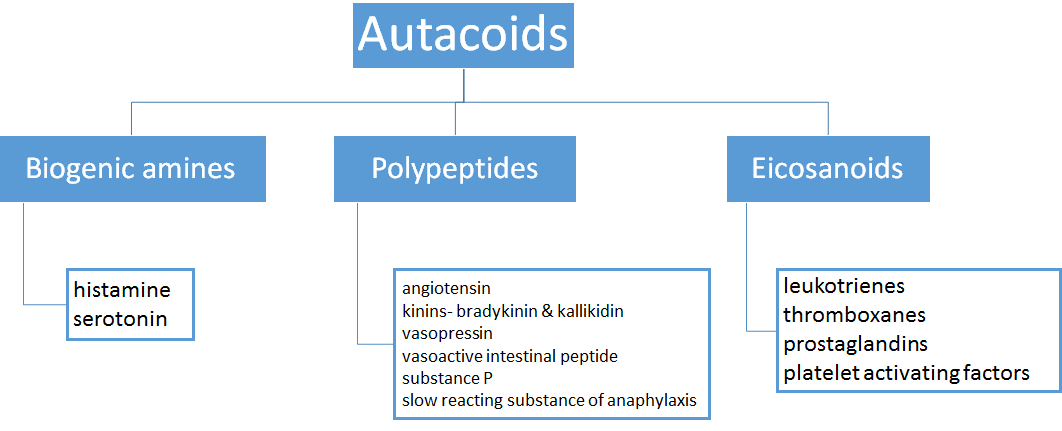Search Page
The search found 15 results in 0.022 seconds.
Search results
-
Histamine
Histamine is a vasoactive amine (a.k.a. a biogenic amine). It acts via a family of G protein-coupled receptors (histamine receptors H1-H4). The histamine receptors are differentially expressed, and couple to different second messenger systems. This results in context-specific effects in response to histamine release.
efaccena - 30/03/2016 - 9:21am
-
Other autacoids

The pharmacology and clinical impact of histamine and serotonin have been described above. This section will focus on other clinically important autacoid molecules.
Autacoids release can be triggered by agents including chemical and immune irritants, UV light, bacterial toxins and physical trauma.
Whilst histamine mediates the wheal, flare and redness reactions, the prostaglandins mediate pain.
efaccena - 29/03/2016 - 1:12pm
-
Antihistamines (under construction)
The antihistamines recommended for or prescribed to treat allergic reactions, occasional insomnia, motion sickness or vertigo, and nausea and vomiting target histamine H1 receptors on mast cells, smooth muscle, endothelium, and in the brain’s tuberomammillary nucleus (a structure of histamine-releasing neurons in the posterior third of the hypothalamus involved in regulating arousal, learning, memory, sleep and energy balance). Antihistamine drugs act mechanistically as receptor antagonists or inverse agonists.
efaccena - 09/09/2016 - 9:21am
-
autacoids
Autacoids are biological factors which act like paracrine hormones: typically having a brief duration of action near the site of synthesis. Examples are histamine and serotonin.
efaccena - 30/03/2016 - 7:39am
-
Antisecretory drugs
In the gastrointestinal system, anti-secretory drugs are used to decrease acid secretion in the stomach.
Drug families include:
Histamine H2 receptor antagonists are used to treat functional dyspepsia and to promote healing of NSAID-associated ulcers e.g. cimetidine and famotidine.
smaxwell - 10/10/2014 - 9:01am
-
Mast-cell stabilisers (under construction)
Mast cell stabilizers are generally cromone derivative type compounds. Mechanistically, they work in part by blocking calcium channels involved in release of preformed chemical mediators such as histamine from intracellular mast cell granules.
efaccena - 12/09/2016 - 10:21am
-
Anti-emetic drugs
Drug-induced emesis can now be largely controlled with anti-emetic drugs, however, nausea remains a very significant clinical problem. This dichotomy suggests that different mechanisms underlie nausea and vomiting.
smaxwell - 10/10/2014 - 7:50pm
-
Immunomodulating drugs (under construction)
Dimethyl fumarate is a prodrug with neuroprotective and anti-inflammatory effects. Its active metabolite is monomethylfumarate (used to treat psoriasis). Oral dimethyl fumarate is used for the treatment of adults with relapsing-remitting multiple sclerosis.
efaccena - 12/09/2016 - 9:49am
-
Gastro-oesophageal reflux disease (GORD)
Gastro-oesophageal reflux disease (GORD; also known as GERD Gastro-esophageal reflux disease)
efaccena - 06/02/2023 - 1:40pm
-
Voltage-gated ion channels
Voltage-gated ion channels (VGICs) are responsive to changes in the local electrical membrane potential, and are critical for the function of excitable cells, such as neurons and muscle cells. VGICs are ion-selective, with separate channels identified for each of the major physiological ions- Na+, K+, Ca2+, Cl-. Each type of channel is a multimeric complex of subunits encoded by a number of genes. Subunit combinations vary in different tissues, with each combination having distinctive voltage dependence and cellular localization.
efaccena - 24/02/2016 - 3:26pm
